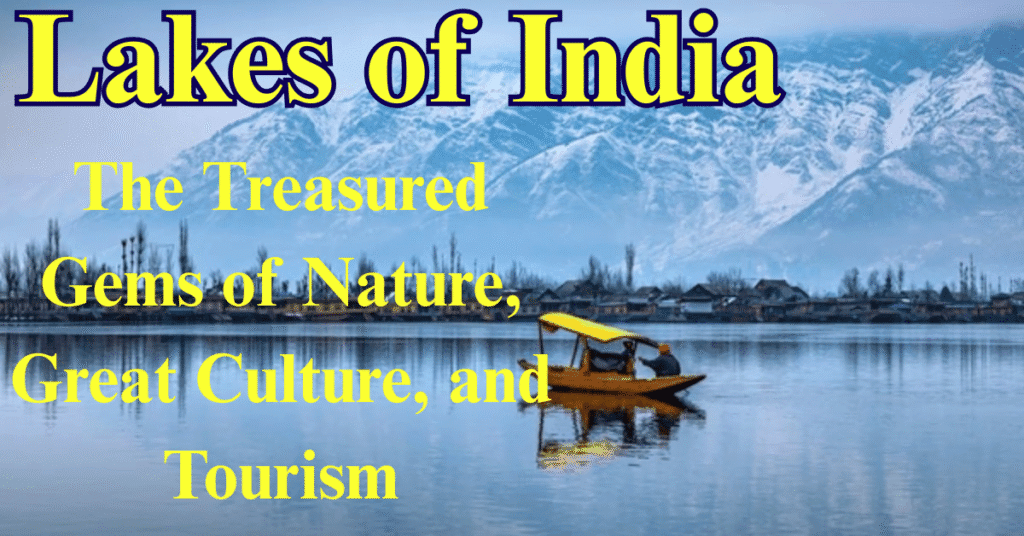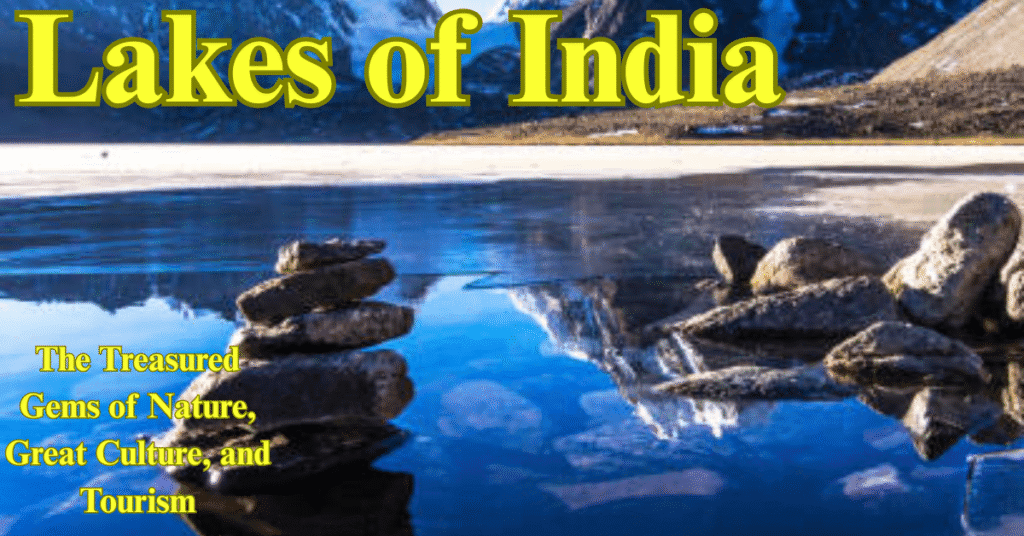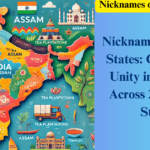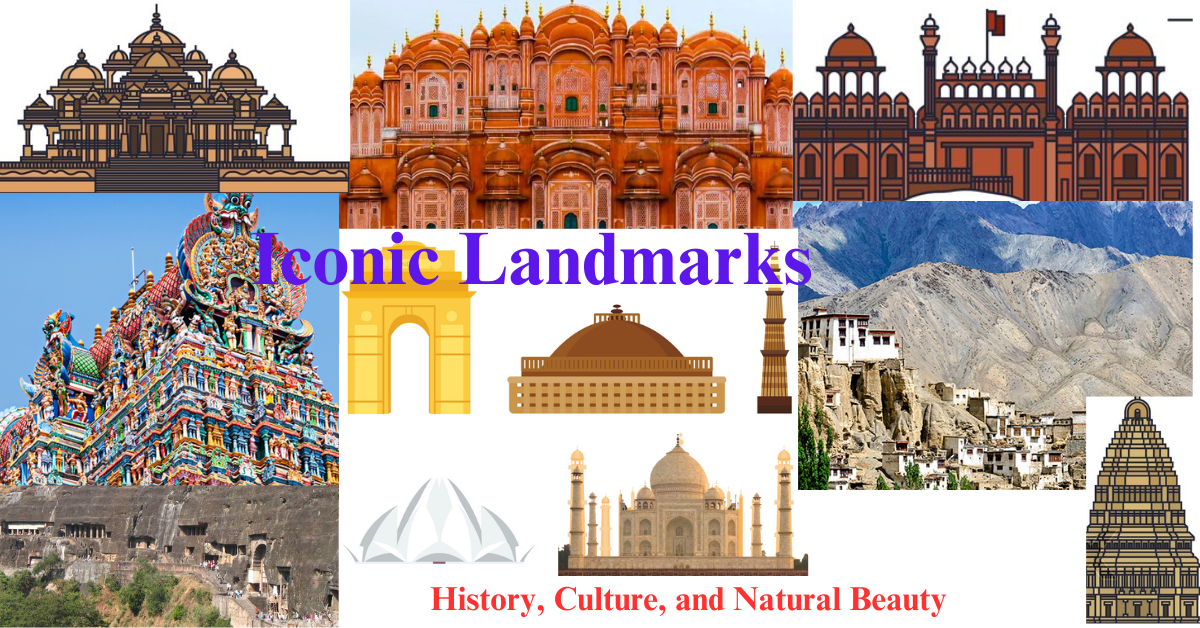
Table of Contents
Lakes of India
Lakes of India
Lakes of India : India is a land of diverse landscapes, where serene lakes are scattered from the snow-capped Himalayas to the lush backwaters of Kerala. These lakes are not just water bodies; they are lifelines for biodiversity, crucial for environmental balance, cultural identity, and economic activities like tourism and fisheries.
In this article, we’ll explore the major lakes of India, their geographical locations, unique features, and ecological and cultural significance.
Explore the most important lakes of India, their locations, unique features, and environmental & cultural significance. A comprehensive guide to India’s lakes.

✅ Northern India’s Major Lakes
1. Dal Lake (Jammu & Kashmir)
- Known as the “Jewel in the crown of Kashmir”, Dal Lake is famous for its scenic beauty, houseboats, and Shikara rides.
- Plays a key role in tourism and fisheries.
- Surrounded by Mughal gardens and floating vegetable markets.
2. Wular Lake (Jammu & Kashmir)
- One of the largest freshwater lakes in Asia.
- Crucial for flood control and groundwater recharge.
- A hotspot for migratory birds and biodiversity.
3. Pangong Tso Lake (Ladakh)
- A high-altitude lake that extends from India to China.
- Known for its stunning blue waters and dramatic mountain backdrop.
- Becomes partially frozen in winter.
4. Tso Moriri Lake (Ladakh)
- A freshwater lake located in the Changthang plateau.
- Recognized as a wetland of international importance under the Ramsar Convention.
- Habitat for rare species like black-necked cranes.
5. Chandratal & Surajtal (Himachal Pradesh)
- High-altitude lakes admired for trekking and nature camping.
- Chandratal is also called the “Moon Lake”.
6. Nainital Lake (Uttarakhand)
- A natural freshwater lake in the town of Nainital.
- Integral to the town’s ecosystem and tourism.
✅ Western India’s Major Lakes
1. Pushkar Lake (Rajasthan)
- A sacred lake surrounded by 52 ghats.
- Site of the famous Pushkar Camel Fair.
- Holds religious significance in Hinduism.
2. Rajsamand Lake (Rajasthan)
- An artificial lake built by Maharana Raj Singh in the 17th century.
- Known for its marble embankments and scenic beauty.
3. Sambhar Salt Lake (Rajasthan)
- India’s largest inland salt lake.
- Key contributor to India’s salt production.
4. Nal Sarovar Lake (Gujarat)
- A bird sanctuary and wetland of national importance.
- Hosts flamingos, pelicans, and other migratory birds.
Lakes of India
✅ Central India’s Major Lakes
1. Upper Lake (Bhopal, Madhya Pradesh)
- Known as “Bhojtal”, this is the oldest man-made lake in India.
- Supplies drinking water to the city of Bhopal.
2. Lonar Crater Lake (Maharashtra)
- Formed by a meteor impact during the Pleistocene Epoch.
- A unique saline soda lake with scientific importance.
Lakes of India
✅ Southern India’s Major Lakes
1. Pulicat Lake (Andhra Pradesh-Tamil Nadu)
- India’s second-largest brackish water lake.
- A vital habitat for flamingos and other waders.
- Supports fishing and salt production.
2. Chilika Lake (Odisha)
- The largest coastal lagoon in India and the second-largest in the world.
- Designated as a Ramsar Wetland Site.
- Known for Irrawaddy dolphins and migratory birds.
3. Vembanad Lake (Kerala)
- The longest lake in India.
- Crucial for Kerala’s backwater tourism and houseboat cruises.
- Acts as a natural flood barrier.
4. Ashtamudi Lake (Kerala)
- Named after its eight arms (“Ashta-mudi” means eight-coned).
- Important for fishing and traditional coir industry.
5. Hussain Sagar & Osman Sagar (Telangana)
- Artificial lakes built for water supply and flood control.
- Hussain Sagar is famous for the giant Buddha statue in Hyderabad.
Lakes of India
✅ Eastern and Northeastern India’s Major Lakes
1. Loktak Lake (Manipur)
- Known for its phumdis (floating biomass islands).
- The world’s only floating national park, Keibul Lamjao National Park, is located here.
- Home to the endangered Sangai deer.
2. Himalaya Sagar Lake, Kolleru Lake (Andhra Pradesh)
- Kolleru is a large freshwater lake between Krishna and Godavari deltas.
- An important bird sanctuary and flood balancing reservoir.
✅ Importance of Lakes in India
| Aspect | Importance |
|---|---|
| Ecological Balance | Lakes support rich biodiversity, act as habitats for birds, fish, and aquatic plants. |
| Water Conservation | Help recharge groundwater, control floods, and store rainwater. |
| Tourism & Economy | Generate employment through tourism, fisheries, and boating activities. |
| Cultural & Religious Significance | Many lakes are pilgrimage sites and hold religious importance. |
| Climate Moderation | Influence local weather patterns and provide cooling effect. |
✅ Challenges Faced by Indian Lakes
- Pollution due to urbanization and industrial waste.
- Encroachments reducing the size of lakes.
- Eutrophication and invasive species harming aquatic life.
- Climate change affecting water levels and ecosystem health.
LakesOfIndia, #IndianLakes, #NaturalBeautyIndia, #EcoTourism, #WetlandsIndia, #CulturalHeritage, #BiodiversityIndia, #WaterConservation, #TravelIndia, #ProtectOurLakes
✅ Conclusion
Lakes of India are more than just water bodies — they are ecological treasures, cultural heritage sites, and vital for human survival. Protecting and restoring them is essential for sustainable development. Collective efforts from government, communities, and individuals are the need of the hour to conserve these beautiful natural resources.


